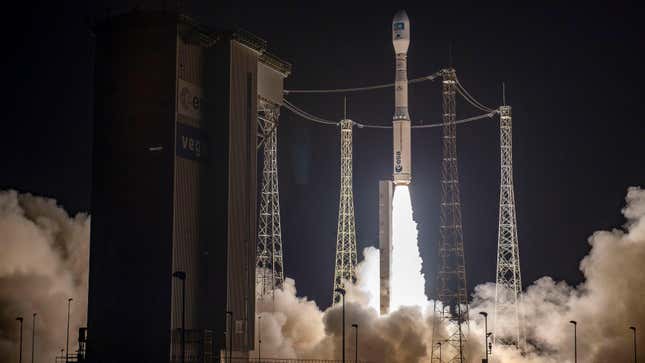
Earlier this week, Arianespace’s Vega-C rocket suffered a fatal anomaly that resulted in the loss of two satellites. The rocket, which debuted a few months ago, was meant to fill a major gap for the European space industry, but is now grounded pending an investigation.
Arianespace and the European Space Agency (ESA) have appointed an independent inquiry commission to analyze the reason for the rocket’s failure on Tuesday and determine what needs to be done before Vega-C can resume flights, according to a statement by Arianespace.
It’s not yet clear how long the Vega-C rocket will be suspended as the independent commission investigates Tuesday’s mission failure. In the wake of a July 2019 mishap, the rocket was grounded for more than a year as the investigation took place, as reported in SpaceNews. The BBC says this is the third time a Vega rocket has suffered a mission failure in the last eight liftoffs.
Vega-C is developed by ESA, built by Italian company Avio, and operated by Arianespace. The rocket took off on Tuesday at 8:47 p.m. ET from the Kourou space base in French Guiana, carrying the Neo 5 and Neo 6 satellites for Airbus’ Pléiades Neo Earth-imaging constellation.
The rocket’s first stage, the new P120C motor, performed as planned. Roughly two and a half minutes after launch, however, ground teams noticed a pressure chamber decrease in the rocket’s second-stage Zefiro-40 engine. “Under standard procedure, the order of destruction of the launcher was given by CNES, the launch safety authority,” Arianespace wrote in the statement.
“We take full charge of the responsibility for this Vega-C failure,” Giulio Ranzo, chief executive of Avio, said during a press conference on Wednesday. The company’s shares fell 9.5% in trading on Wednesday, according to SpaceNews.
This was Vega-C’s second time to fly and its first time to carry a commercial payload. On July 13, Vega-C successfully completed its inaugural flight, delivering the Italian Space Agency’s LARES-2 to orbit as its primary payload. Vega-C was on tap to perform as many as 10 flights in 2023 and another 15 in 2024. The rocket’s suspension will undoubtedly serve as a major inconvenience to a number of key missions and potentially create a nasty backlog.
Vega-C is the highly anticipated successor to the Vega launcher, which had been in operation for 10 years. The updated rocket is designed to be more efficient, as it’s outfitted with a more powerful first and second stage, as well as an improved re-ignitable upper stage. The timing of Vega-C’s arrival was good, given Russia’s invasion of Ukraine and the ensuing geopolitical complications.
Indeed, ESA previously relied on Russia’s Soyuz medium-lift rockets to launch many of its missions to space. But in February, Russia halted Soyuz launches from French Guiana and pulled its personnel from the space base in response to European sanctions imposed against it. That left key missions in limbo, including two Galileo navigation satellites, ESA’s Euclid space observatory, EarthCARE Earth science satellites, and a French reconnaissance satellite.
Europe suddenly had little to choose from in terms of launch vehicles, as it awaited for the inaugural flights of Vega-C and Ariane 6. Ariane 6, a successor to Ariane 5, was originally slated for launch in 2020, but has suffered numerous delays and is now scheduled to fly in 2023.
ESA eventually turned to SpaceX after weighing its options between the Elon Musk-led company and rockets supplied by either Japan or India. During an interview with Reuters in August, ESA’s Director General Josef Aschbacher said SpaceX is “the more operational of those and certainly one of the back-up launches we are looking at.”
“Sorry to hear this,” wrote Musk on Twitter yesterday in response to the rocket failure. “It is a sobering reminder of the difficulty of orbital space flight.”
ESA was counting on Vega-C to start lifting European payloads to orbit, tasks that have now been put on hold as a result of Tuesday’s mission failure. Hopefully ESA and its private partners will quickly recover from this setback and start launching payloads on a more consistent basis.
More: SpaceX Rival Loses Hundreds of Millions Over Cancelled Russian Launches